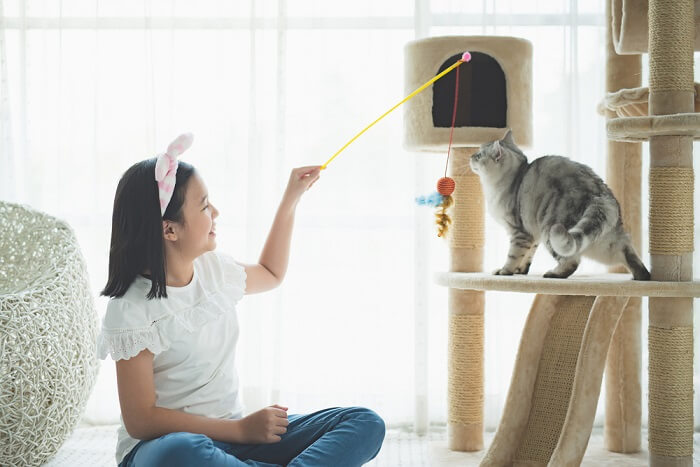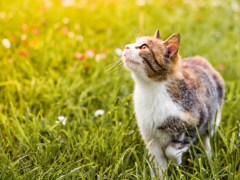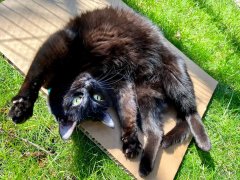
Maria Sbytova / Shutterstock.com
Iron supplements may be used in cats suffering from iron deficiency anemia or blood loss. In this article, you’ll learn about the two most common types of iron supplements, how they’re used and the necessary precautions.
About Iron Supplements for Cats

One of the most common reasons to supplement iron is for cats with chronic kidney disease who develop chronic anemia. Andriy Blokhin / Shutterstock.com
Iron is a necessary mineral involved with red blood cell production and function. It is necessary for the production of red blood cells and specifically hemoglobin, which is the protein that transports oxygen to different organs and tissues through the bloodstream.
Loss of iron in the blood (iron deficiency anemia) is one indication for supplementing iron.
In cats, the most common cause of iron deficiency anemia is a source of slow chronic blood loss. Low iron levels may also occur due to a very unbalanced poor diet low in iron and/or iron-rich foods.
Iron supplementation may also be needed in cats receiving an erythropoiesis-stimulating (red blood cell production-stimulating) agent like erythropoietin or darbepoetin. The most common reason these agents are needed in cats are due to anemia from chronic kidney disease.
When red blood cell stimulating agents are used, the body’s iron stores (which may already be at risk from the anemia itself) can be quickly depleted from the increased production of red blood cells, requiring supplementation.
There are two main types of iron supplements that may be used in cats.
1. Iron Dextran
Iron dextran is a form of iron that is given via an injection in the muscle (usually by your vet). After injection, about 60% is absorbed after 3 days and nearly 100% after 1-3 weeks. The advantage of iron dextran for cats is that it only needs to be given once a month in most cases. The disadvantage is that the injection can only be given in the muscle tissue and can be a painful injection.
2. Ferrous Sulfate
Ferrous sulfate is an oral form of iron supplementation. While an advantage is that it can be given at home, disadvantages include the need to give it daily and that some cats may not tolerate oral iron supplements well. Signs of digestive upset, while usually mild, can be common.
Whether or not your cat needs iron supplementation depends on the disease present causing anemia, your vet’s diagnosis through physical exam findings and blood work testing. The most important test to diagnose anemia is a complete blood count (CBC). A CBC looks at the percentage of erythrocytes (red blood cells), and hemoglobin levels. Certain patterns on a CBC may support the presence of chronic blood loss, or iron deficiency anemia.
A blood work chemistry panel that checks kidney values is also important to know if kidney disease is present and may be an underlying cause of anemia.
Not all anemic cats require iron supplementation. Pale gums alone are not an indication either, as pale gums are not always caused by anemia.
For example, it is not considered needed for most cases of acute blood loss. In severe cases where blood transfusions are used, the body is not required to mobilize its own iron stores and there is no chronic iron loss to address.
Dosing Information for Cats

Ferrous sulfate is one of two iron supplement medications used in cats. luchschenF / Shutterstock.com
Dosing information cannot be specifically provided. The dosage will depend on several factors:
- The cause of anemia
- The degree/severity of anemia
- The protocol for erythropoietin-stimulating agents being used
- Blood iron levels
Inappropriate use or overdosage of either ferrous sulfate or iron dextran injections can incur severe side effects, caused by iron poisoning/toxicity. Dosing should always be provided through a licensed veterinarian. Routine monitoring during iron supplementation is necessary.
When an actual condition requiring iron supplementation is present, it’s important to use products recommended or prescribed by your veterinarian. There are many over-the-counter oral supplements and formulas. The amounts of iron they contain can vary and may be expressed as the amount of iron bound to other minerals versus elemental iron, which can be confusing. If you have an iron supplement for your cat, make sure to get your vet’s opinion for a recommended dosage.
Side Effects of Iron Supplements for Cats
When used at appropriate doses, side effects of iron supplementation are usually mild.
For oral ferrous sulfate side effects are largely from gastrointestinal upset:
- Vomiting
- Diarrhea
- Nausea
- Abdominal discomfort
- Constipation
- Reduced appetite
For iron dextran injections, the most common side effect is pain during the injection in muscle and soreness for a couple of days after.
Overdose and Emergencies

Vomiting and other digestive upset signs can be seen initially with overdoses of iron supplements. ANASTASIIAKU / Shutterstock.com
Overdoses of oral ferrous sulfate can easily lead to iron poisoning and should be considered an emergency. Signs of iron poisoning initially include:
- Acute vomiting (sometimes with blood)
- Abdominal pain
- Diarrhea
Following initial GI upset, more severe signs may occur within a couple of hours including:
- Weak, rapid pulses
- Collapse
- Pale or blue-tinged gums
- Unbalanced walking
- Coma
In some patients, these signs do not occur. Instead, more vague signs of illness are present for 12-48 hours after which a different set of severe illness signs occurs:
- Pulmonary edema (fluid around the lungs causing labored breathing)
- Loss of motor (muscle) function
- Blue-tinged gums
- Acute liver failure
- Coma
- Death
For iron dextran injections, anaphylactic reactions have been described but are considered very rare.
Potential Drug Interactions With Iron Supplements
There are a few medications that may interact with iron supplementation. Use together is not necessarily inappropriate. Costs and benefits should be considered in light of a cat’s health condition and through guidance from your veterinarian.
Iron Dextran
Angiotensin-converting enzyme (ACE) inhibitors: increased risk of anaphylactic reactions has been documented in people, but not in pets.
- Chloramphenicol: may delay the response to iron administration
- Dimercaprol (BAL): use together may increase the risk for kidney toxicity
- Mycophenolate: use together may decrease the benefits of mycophenolate
- Ferrous sulfate
- Alendronate: separate by 2 hours to prevent reduced absorption of alendronate
- Antacids containing aluminum or magnesium: separate by 2 hours to avoid decreased absorption of iron
- Calcium supplements: separate by 2 hours to avoid decreased iron absorption
- Chloramphenicol
- Fluoroquinolone antibiotics (marbofloxacin, pradofloxacin): separate by 2-4 hours to avoid reduced absorption of the fluoroquinolone.
- H2 receptor antagonists (famotidine): may decrease iron absorption
- Levothyroxine: separate by 4 hours to avoid reduced absorption of levothyroxine
- Mycophenolate
- Penicillamine: separate by 1 hour to avoid decreased absorption of penicillamine
- Proton pump inhibitors (omeprazole): may decrease iron absorption
- Tetracyclines: use together with iron supplements may reduce absorption of both medications.
- Vitamin C: may enhance the absorption of iron.
How To Store Iron Complements for Cats
Ferrous sulfate tablets should be stored in tight, light-resistant containers at room temperature (60 degrees F to 86 degrees F). Liquid preparations should also be stored at room temperature but have a narrower temperature range (68 degrees F to 77 degrees F).
Iron dextrans vials should be stored at room temperature (59 degrees F to 86 degrees F). Vials should be discarded 60 days after the first use.
Drug Dosing Disclaimer: We can only provide doses for medications that are FDA-approved for use in cats and only as the label guidelines dictate. For medications that are used off-label, we can only provide guidelines and safety information. Safe and appropriate dosing for off-label medications can only be determined by a primary care veterinarian.
We encourage you to work with your veterinarian to determine if a particular medication is appropriate for your cat. Changing or adjusting a dose for your cat on your own without consulting with a veterinarian can carry risk. We do not encourage the use of medications prescribed for human use in pets without first consulting with a primary care veterinarian.
Iron Supplements for Cats Overview

- Oral supplements: No
- Injectable forms: Yes
-
A Budde, J., & A McCluskey, D. (2023). Iron Dextran [Professional app]. In Plumb’s Veterinary Drug Handbook (10th ed.). Wiley Blackwell.
-
A Budde, J., & A McCluskey, D. (2023). Ferrous Sulfate [Professional app]. In Plumb’s Veterinary Drug Handbook (10th ed.). Wiley Blackwell.
-
Gollakner, R. (n.d.-c). Ferrous Sulfate. VCA Animal Hospitals. Retrieved January 15, 2025, from https://vcahospitals.com/know-your-pet/ferrous-sulfate
-
Hunter, T., Weir, M., & Ward, E. (n.d.). Anemia in Cats. VCA Animal Hospitals. Retrieved January 15, 2025, from https://vcahospitals.com/know-your-pet/anemia-in-cats
-
Naigamwalla, D. Z., Webb, J. A., & Giger, U. (2012, March 1). Iron deficiency anemia. https://pmc.ncbi.nlm.nih.gov/articles/PMC3280776/
-
Boatright, K. (2023, November). Managing anemia in cats with chronic kidney disease. Dvm360. Retrieved January 15, 2025, from https://www.dvm360.com/view/managing-anemia-in-cats-with-chronic-kidney-disease
-
Gorman, L. (n.d.). Anemia of Chronic Kidney Disease in Cats. Mspca Angell. Retrieved January 15, 2025, from https://www.mspca.org/angell_services/anemia-of-chronic-kidney-disease-in-cats/
-
Albretsen, J. & Covance Laboratories. (2006). Toxicology Brief: Managing common poisonings in companion animals - the toxicity of iron, an essential element. In P. A. Volmer & College of Veterinary Medicine, University of Illinois, Veterinary Medicine. https://www.aspcapro.org/sites/default/files/zn-vetm0206_082-090_0.pdf







